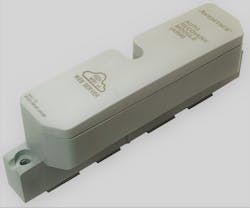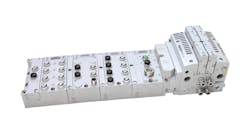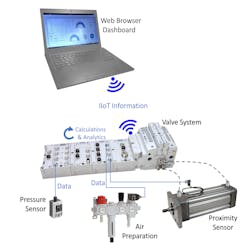The world around us is becoming more and more wireless every day. Our smartphones, tablets, and laptop computers are essential tools, and technologies such as Wi-Fi and Bluetooth provide ubiquitous connectivity that has come to be accepted as part of modern life.
Wireless technology is also making its way into the world of automation and manufacturing, although not with the same level of speed and penetration. Wireless technology is today widely deployed to connect sensors—temperature, pressure, flow rate monitors, etc.—in many process industry systems such as refineries and chemical plants.
These installations are large, and their sensors are widely distributed. With the advent of reliable wireless communications interfaces, it is now easier to network these devices over the air, rather than invest the time and expense to physically connect them.
One of the most common uses of wireless technologies in manufacturing platforms is wireless human-machine interfaces (HMIs). Many automation and controls platform suppliers have routinely included wireless HMIs as part of their portfolios for several years.
This is done to give machine operators the freedom to move about the plant floor and still maintain real-time control of their machines. Wireless HMIs equip operators to respond to issues immediately, rather than having to return to an operator station.
These wireless HMIs connect to wireless interface devices that are integrated into standard, high-speed automation network interfaces, such as ProfNet and EtherNet/IP. These networks are also used to connect machine control and automation functions like PLCs, servos, I/O, and various actuator devices.
Emerson’s AVENTICS has now added a powerful wireless module to the wireless technology options available to automation system OEMs and end-users: the Wireless Auto Recovery Module, or Wireless ARM. The Wireless ARM enables easy pneumatic valve system commissioning and configuration, as well as real-time access to pneumatic component diagnostics.
Proven Value of Smart Pneumatic Technology
Pneumatics is one of the most widely used and effective technologies in today’s automation systems. Pneumatic systems are ideal because they are proven to provide long operational life as well as a low-cost and effective way to add various motion to equipment.
Pneumatics is also becoming much “smarter” and getting a fresh look from the OEM community as technology suppliers like Emerson add intelligence to these widely used devices.
Today, as sensing technology has advanced, it is now easier to monitor these pneumatic actuators and get actionable data without being cost-prohibitive. Pneumatics now ties in with the overall automation system to provide comprehensive, actionable performance data that can improve overall equipment effectiveness (OEE).
These smart pneumatic technologies deliver actionable data, in real-time, that machine operators and plant engineers use in two critical ways: to immediately respond to problems and issues with pneumatic components and to correct them before they cause significant problems or lead to significant downtime for automation systems.
Robust, high-performance pneumatic systems with real-time sensor data also provide the basis for data-driven, preventative maintenance programs. Data on valve performance, and whether pneumatic function is falling outside of established thresholds, now provides the basis for more predictive maintenance programs, helping to prevent unscheduled downtime by planning for component servicing and replacement in the most efficient manner possible.
New Wireless Tools Enhance Pneumatics for Automation
Many complex automation systems can have numerous pneumatic components, many of which now incorporate sensors. How is that data captured and managed? Major pneumatics suppliers are deploying advanced, modular Fieldbus valve system interfaces. For example, Emerson’s AVENTICS Series G3 electronic Fieldbus valve system replaces conventional hardwired solutions and integrates communication interfaces and Input/Output (I/O) capabilities to pneumatic valve manifolds.
The G3 platform is a modular and scalable system that permits easy access to its module components; it's simple to assemble, install, commission, and maintain. It supports a full range of automation communications protocols, including EtherCAT, EtherNet/IP, ProfiNet, etc. This enables PLCs to turn valves on and off more efficiently and to channel I/O data from sensors, lights, relays, individual valves or other I/O devices via various industrial networks.
State-of-the-art pneumatic fieldbus valve systems like the AVENTICS Series G3 help simplify commissioning, installation, and integration of pneumatic valves into the overall automation system. They enable faster start-ups and enhanced diagnostics that help identify problems earlier and faster—contributing to increased equipment uptime and greater productivity.
The Series G3 platform now adds an industry-first wireless capability with the launch of the Wireless ARM. The modular Wireless ARM is engineered to be easily added as a “clip” into existing G3 fieldbus platforms. It provides real-time access to pneumatic component diagnostics, as well as supports easy valve system commissioning and configuration—two key advantages many automation system OEMs and end users are seeking.
Sensor data from pneumatic devices networked through the G3 fieldbus platform are sent via secured Wi-Fi connection to a web-based dashboard that can be accessed by any smartphone, tablet or laptop. Using the Wireless ARM allows the valve manifolds to be fully commissioned and monitored prior to machine startup; this includes setting operational thresholds and alarm settings.
It’s an example of how wireless interfaces can more easily support a fieldbus platform’s diagnostic and commissioning capabilities via an internal Wi-Fi access point. This wireless access can improve operational convenience and efficiency, especially in machine settings where the valve system is located inside the machine or on the ceiling.
This web interface can also be used to commission all the features of the fieldbus module when it is first integrated into the overall automated production system. Operators using a wireless laptop or tablet can commission networking features such as IP address, subnet mask, and gateway addresses for the fieldbus module, as well as valve manifold settings such as baud rates, etc.
Once the automated system is up and running, error notifications for alarms, voltage levels, short circuits, module errors, open load errors, and distribution errors are delivered to the web-based dashboard, which can be configured so laptops or smartphones can get alerts if critical thresholds threaten to be exceeded.
Devices ranging from pneumatic cylinders and valve manifolds to pressure sensors and air preparation units are constantly generating performance data. This is essential data that operators need so they understand how all the pneumatic devices connected through the fieldbus communication interface are performing and can be diagnosed when problems occur during production.
Machine operators can use these alarms for detailed guidance about precisely which device or valve component may be approaching failure thresholds; that provides the kind of actionable data needed to support the servicing of a device during the next scheduled downtime for machine maintenance.
Performance and diagnostic data that is aggregated to the website dashboard is, obviously, pneumatic-specific. However, the end-user can combine that data with other data from the machine’s PLC and other sensors in order to conduct more sophisticated analytics about overall automation performance. Using this real-time data to develop deeper insights into machine productivity and energy efficiency.
One application that benefits from such prolific and detailed real-time performance and diagnostic data is the engine test stand. Engine test stands are just what they sound like. They’re used to run vehicle engines, often to their limits, to monitor the engine’s overall performance.
Pressure sensors are key measurement components found throughout these testing systems. Recently, a motor vehicle manufacturer needed to select multiple squeezes and test pressures when using their engine test stands. The manufacturer partnered with Emerson to find a compact, engineered pneumatics solution with a small footprint that could solve their challenge.
Emerson recommended the AVENTICS Series 503 direction control valve, which has ultra-high flow ratings per valve size, and the Ethernet G3 platform, the Wireless ARM and I/O as well as safety lockout valves with air preparation and flow controls.
This all-in-one pneumatics solution combined ultra-high flow rates with a user-friendly way to capture and manage sensor data. It not only fit the machine mounting envelope, the solution integrated communication interfaces and I/O capabilities to pneumatic valve manifolds within the engine test stand. The pneumatic valve manifold with sandwich regulators was able to solve the manufacturer’s challenge to select pressure, and the addition of the wireless ARM made it possible for the manufacturer to access real-time pneumatic component diagnostics.
Automated Recovery Capability
Coupled with wireless access to commissioning and diagnostics, the wireless ARM also provides an automated recovery capability. Each time the fieldbus manifold is powered up, its configuration and parameter settings are saved into the wireless ARM module’s nonvolatile memory.
If there is a power spike or other critical event which damages any of the modules of the G3 system, the modular ARM device will automatically reconfigure any replacement modules without the need of a laptop or user commissioning. The auto-recovery module (ARM) automatically saves all the configuration data, avoiding valuable time loss and allowing the valve manifold to quickly get back into service.
This kind of backup intelligence, based on the use of smart digital technology, is a key requirement for many automation end-users: Instead of requiring a controls engineer to recover and reprogram the valve system functionality through the PLC or laptop, a service technician or machine operator can easily perform the replacement to restore the valve function with minimal effort and without using any special tools or software.
Wireless Expands IoT Capabilities in Automation
The Wireless ARM module demonstrates a key IoT principle: using advanced digital technology to maximize the uptime and productivity of complex automation systems. Wireless interfaces can simplify and streamline how plant floor personnel or maintenance technicians access diagnostics from pneumatic valve systems. There’s no need to gain access to the machine’s network or download a special app—the real-time, actionable data is safely available via a standard web browser.
The Wireless ARM is not meant to replace high-speed, wired automation networks like EtherNet/IP or ProfiNet, for valve control. Rather, it provides a simple wireless diagnostic interface into smart pneumatic valve systems platforms and represents a key addition to the expanding range of smart digital technologies being integrated into today’s pneumatics.
It is also an example of how companies like Emerson continue to invest in innovation and advanced thinking about ways to leverage proven technologies like wireless connectivity. As a result, manufacturers are able to reduce production downtime and simplify valve system commissioning. In addition, these developments are designed to create a path for using diagnostics and pneumatic device performance data for analytics and further expanding IIOT functionality.
About the Author




